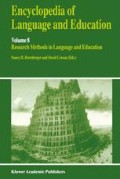Abstract
Although the theoretical and practical significance of studying language development in blind children is well documented (Fraiberg, 1977; Urwin, 1978; Mulford, 1988), a number of methodological issues make this field challenging to researchers. This section identifies such issues and the ways they have been handled since the 1940’s. In particular: concerns surrounding the comparison of language functioning between blind and sighted groups; the difficulties in comparing outcomes between different studies; the way theoretical frameworks and techniques used with sighted children have been applied to the study of blind children; and the issues around establishing knowledge about patterns of language development from studies based on small samples. Ways in which future developments in methodology may best advance knowledge about language acquisition in blind children are discussed.
Access this chapter
Tax calculation will be finalised at checkout
Purchases are for personal use only
Preview
Unable to display preview. Download preview PDF.
References
Anglin, J.M.: 1977, Word, Object and Conceptual Development, Norton, New York.
Bigelow, A.E.: 1982, ‘Early words of blind children’, Paper presented at the International Conference on Infant Studies, Austin, Texas, March.
Bigelow, A. E.: 1983, ‘Development of the use of sound in the search behavior of infants’, Developmental Psychology 19, 317–321.
Burlingham, D.: 1961, ‘Some notes on the development of the blind’, Psychoanalytic Study of the Child 16, 121–145.
Burlingham, D.: 1965, ‘Some problems of ego development in blind children’, Psychoanalytic Study of the Child 20, 194–208.
Cass, H.D, Sonksen, P.M. & McConachie, H.R.: 1994, ‘Developmental setback in severe visual impairment’, Archives of Disease in Childhood, 70, 192–196.
Dunlea, A.: 1989, Vision and the Emergence of Meaning, Cambridge University Press,Cambridge.
Fenson, L., Dale, P.S., Reznick, J.S., Bates, E., Hartung, J., Pethick, S. & Reilly, J.: 1993, The MacArthur Communicative Development Inventories: User’s Guide and Technical Manual, Singular Publishing Group, San Diego.
Fraiberg, S.: 1977, Insights From the Blind, Basic Books, New York.
Garwood, S.: 1983, Educating Young Handicapped Children: A Developmental Approach (second edition), Aspen systems Cooperation, Rockville, Maryland.
Keeler, W.R.: 1958, ‘Autistic patterns and defective communication in blind children with retrolental fibroplasia’, in PH. Hoch & J. Zubin (eds.), Psychopathology of Communication, Grune and Stratton, New York, 64–84.
Landau, B.: 1995, Language and Experience in Blind Children: Retrospective and Prospective, Paper presented at the Mary Kitzinger Trust Symposium, Blindness and Psychological Development, 0–10 years. September 5–6th, University of Warwick, UK.
Lewis, V. & Collis, G.M.: in press, Blindness and Psychological Development in Young Children, British Psychological Publications, Leicester.
McConachie, H.R. & Moore, V.: 1994, ‘Early expressive language of severely visually impaired children’, Developmental Medicine and Child Neurology 36, 230–240.
McGinnis, A.: 1981, ‘Functional linguistic strategies of blind children’, Journal of Visual Impairment and Blindness 75(5), 210–214.
Merriman, W.E. & Tomasello, M.: 1995, ‘Introduction: Verbs are words too’, in M. Tomasello & W.E. Merriman (eds.), Beyond Names for Things, Lawrence Erlbaum Associates, Hillsdale, NJ.
Miecznikowski, A. & Andersen, E.: 1986, ‘From formulaic to analysed speech: Two systems or one?’, in J. Connor-Linton, C.J. Hall & M. McGinnis (eds.), Southern California Occasional Papers in Linguistics, Volume 11, University of Southern California Department of Linguistics, Los Angeles.
Miller, G.A.: 1963, Language and Communication (revised edition), McGraw-Hill Book Co., New York.
Mills, A.: 1983, ‘Acquisition of speech sounds in the visually handicapped child’, in A. Mills (ed.), Language Acquisition in the Blind Child, Croom Helm, London.
Mulford, R.: 1988, ‘First words of the blind child’, in M.D. Smith & J.L. Locke (eds.), The Emergent Lexicon: The Child’s Development of a Linguistic Vocabulary, Academic Press, London.
Norgate, S.H.: 1996, Conceptual and Lexical Functioning in Blind, Severely Visually Impaired and Sighted Infants, Unpublished PhD doctoral dissertation, Warwick University.
Norris, M., Spaulding, P.J. & Brodie, F.H.: 1957, Blindness in Children, University of Chicago Press, Chicago.
Peters, A.M.: 1994, ‘The interdependence of social, cognitive, and linguistic development: Evidence from a visually impaired child’, in H. Tager-Flusberg (ed.), Constraints on Language Acquisition, Lawrence Erlbaum, London.
Plomin, R.: 1995, Editorial comment in CM. Shore, Individual Differences in Language Development, Sage, London.
Reynell, J.: 1979, Manual for the Reynell-Zinkin Scales, NFER, London.
Stone, L.J. & Church, J.; 1957, Childhood and Adolescence: A Psychology of the Growing Person, New York, Random House.
Urwin, C: 1978, The Development of Communication Between Blind Infants and Their Parents: Some Ways into Language, Unpublished PhD doctoral dissertation, University of Cambridge.
Walker, E., Tobin, M. & McKennell, A.: 1992, Blind and Partially Sighted Children in Britain: the RNIB Survey, Volume 2, HMSO, London.
Warren, D.H: 1994, Blindness and Children: An Individual Differences Approach, Cambridge University Press, Cambridge.
Wilson, R.B.: 1985, The Emergence of Semantics of Tense and Aspect in the Language of a Visually Impaired Child, Unpublished DPhil doctoral dissertation, University of Hawaii.
Author information
Authors and Affiliations
Editor information
Editors and Affiliations
Rights and permissions
Copyright information
© 1997 Springer Science+Business Media Dordrecht
About this chapter
Cite this chapter
Norgate, S.H. (1997). Research Methods for Studying the Language of Blind Children. In: Hornberger, N.H., Corson, D. (eds) Encyclopedia of Language and Education. Encyclopedia of Language and Education, vol 8. Springer, Dordrecht. https://doi.org/10.1007/978-94-011-4535-0_16
Download citation
DOI: https://doi.org/10.1007/978-94-011-4535-0_16
Publisher Name: Springer, Dordrecht
Print ISBN: 978-0-7923-4935-8
Online ISBN: 978-94-011-4535-0
eBook Packages: Springer Book Archive

